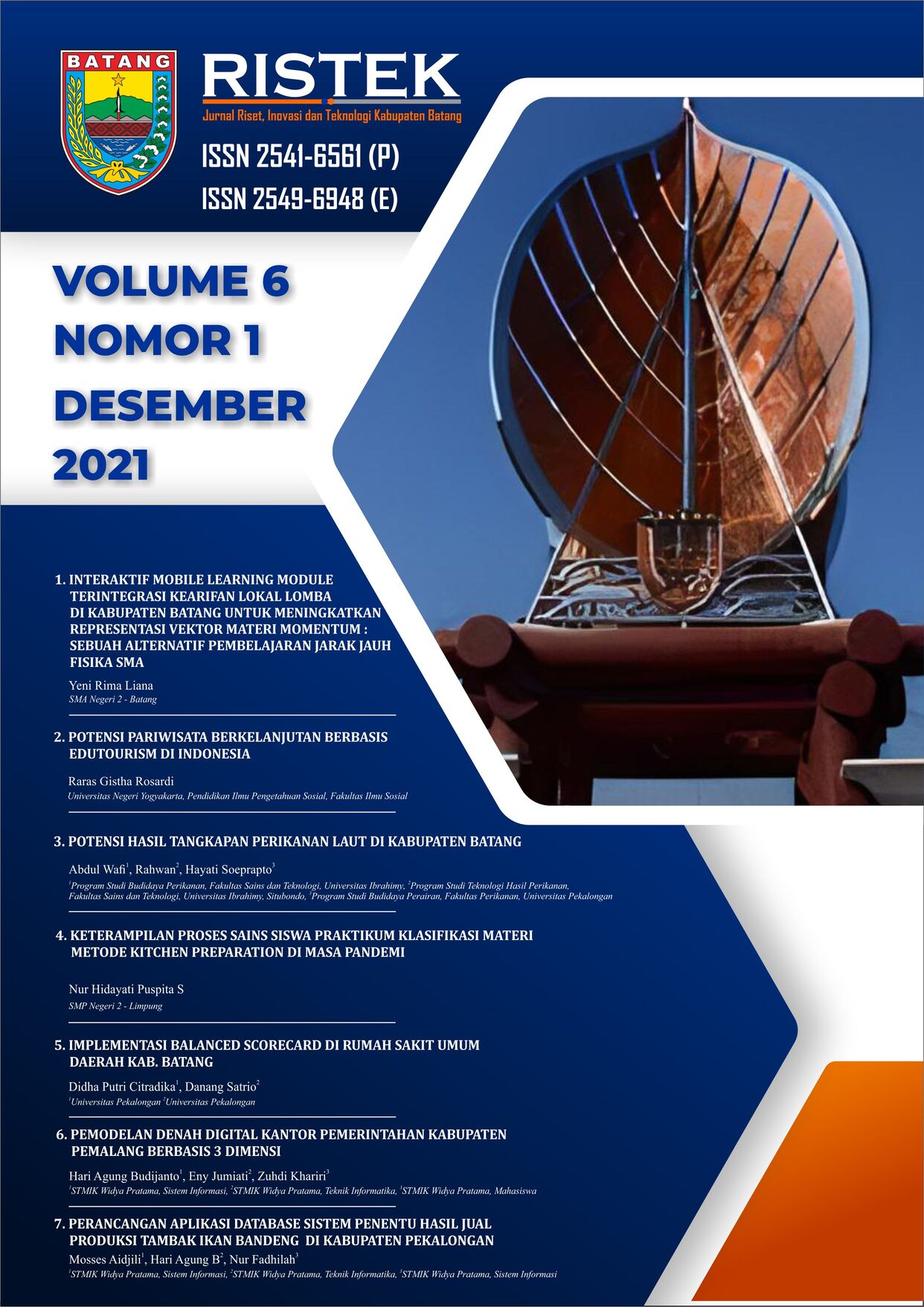INTERAKTIF MOBILE LEARNING MODULE TERINTEGRASI KEARIFAN LOKAL LOMBA DI KABUPATEN BATANG UNTUK MENINGKATKAN REPRESENTASI VEKTOR MATERI MOMENTUM: SEBUAH ALTERNATIF PEMBELAJARAN JARAK JAUH FISIKA SMA
DOI:
https://doi.org/10.55686/ristek.v6i1.104Kata Kunci:
Interaktif Mobile Learning Modul, kearifan lokal, representasi vektorAbstrak
Penelitian ini dilakukan untuk menganalisis kelayakan dan keefektifan Interaktif Mobile Learning Module terintegrasi kearifan lokal lomba di Kabupaten Batang terhadap peningkatan representasi vektor materi momentum peserta didik. Desain penelitian menggunakan pretest-posttest control group design. Subjek penelitian terdiri dari dua orang dosen sebagai validator ahli, enam orang guru fisika dan 108 peserta didik kelas XI SMAN 2 Batang. Instrumen penelitian ini berupa angket validasi ahli, angket respon guru, angket respon peserta didik, dan tes tertulis. Validasi instrumen tes menggunakan Aiken’s V. Teknik analisis uji kelayakan media menggunakan kategori penilaian baku skala lima, sedangkan uji keefektifan media menggunakan analisis uji Multivariate Test pada General Linear Model (GLM). Penilaian instrumen tes kemampuan representasi vektor materi momentum Interaktif Mobile Learning Modul, berada pada kriteria valid. Analisis hasil uji keefektifan Interaktif Mobile Learning Module memeroleh nilai MD sebesar -37,331 dengan taraf Sig.<0,05 menunjukkan adanya perbedaan yang signifikan kemampuan representasi vektor materi momentum sebelum dan sesudah menggunakan Interaktif Mobile Learning Module
Unduhan
Referensi
Adi, N. P., Istiyono, E., Y, R. A., Zaini, M., & A, S. Q. M. J. (2017). Physics Comprehensive and Contextual Teaching Material ( PhysCCTM ) untuk Meningkatkan Higher Order Thinking Skill ( HOTS ) Siswa SMA. Prosiding SNFA (Seminar Nasional Fisika Dan Aplikasinya), 164–173.
Aiken, L. (1985). Three Coefficients for Analyzing The Reliability and Validity of Ratings. Educational and Psychological Measurement, 45, 131–142.
Almarzooq, Z. I., Lopes, M., & Kochar, A. (2020). Virtual Learning During The Covid-19 Pandemic: A Disruptive Technology In Graduate Medical Education. Journal of the American College of Cardiology, 75(20), 2635–2638. https://doi.org/10.1016/J.Jacc.2020.04.015.
Ambarita, J., Helwaun, H., & Houten, L. Van. (2021). Workshop Pembuatan E-book Sebagai Bahan Ajar Elektronik Interaktif Untuk Guru Indonesia Secara Online di Tengah Covid 19. Community Engagment & Emergence Journal, 2(1), 44–57.
Andarini, H. D., Swasty, W., & Hidayat, D. (2016). No Title. Designing the Interactive Multimedia Learning for Elementary Students Grade 1 St -3 Rd a Case of Plants ( Natural Science Subject ), 4(c), 1–5.
Barniol, P., & Zavala, G. (2014a). Students ’ difficulties in problems that involve unit-vector notation. Latin American Journal of Physics Education, 8(4).
Barniol, P., & Zavala, G. (2014b). Test of understanding of vectors: A reliable multiple-choice vector concept test. Physical Review Special Topics - Physics Education Research, 10(1), 1–14. https://doi.org/10.1103/PhysRevSTPER.10.010121
Barniol, P., & Zavala, G. (2014c). Test of Understanding of Vectors: A Reliable Multiple-Choice Vector Concept Test. Physical Review Special Topics - Physics Education Research, 10(1), 1–14.
Bollen, L., Kampen, P. Van, Baily, C., & Kelly, M. (2017). Student difficulties regarding symbolic and graphical representations of vector. PHYSICAL REVIEW PHYSICS EDUCATION RESEARCH, 13(August), 1–17. https://doi.org/10.1103/PhysRevPhysEducRes.13.020109
Bollen, L., Kampen, P. Van, & Cock, M. De. (2015). Students ’ difficulties with vector calculus in electrodynamics. 020129, 1–14. https://doi.org/10.1103/PhysRevSTPER.11.020129
Capurso, M., Dennis, J. L., Salmi, L. P., Parrino, C., & Mazzeschi, C. (2020). Empowering Children Through School Re-Entry Activities After the COVID-19 Pandemic. Continuity in Education, 1(1), 64–82.
Chu, J., Rittle-Johnson, B., & Fyfe, E. R. (2017). Diagrams benefit symbolic problem-solving. British Journal of Educational Psychology, 87(2), 273–287. https://doi.org/10.1111/bjep.12149
De Cock, M. (2012). Representation Use and Strategy Choice in Physics Problem Solving. Physical Review Special Topics - Physics Education Research, 8(2), 1–15.
Dewi, I. N., Poedjiastoeti, S., Prahani, K., & Sri Poedjiastoeti. (2017). Elsii Learning Model Based Local Wisdom To Improve Students’ Problem Solving Skills and Scientific Communication. International Journal of Education and Research, 5(1), 107–118.
Docktor, J. L., & Mestre, J. P. (2014). Synthesis of discipline-based education research in physics. Physical Review Special Topics - Physics Education Research, 10(2), 1–58.https://doi.org/10.1103/PhysRevSTPER.10.020119
Heckler, A. F., & Scaife, T. M. (2015). Adding and subtracting vectors: The problem with the arrow representation. Physical Review Special Topics - Physics Education Research, 11(1), 1–17. https://doi.org/10.1103/PhysRevSTPER.11.010101
Hill, M., Sharma, M. ., & Johnston, H. (2015). How online learning modules can improve the representational fl uency and conceptual understanding of university physics students. European Journal of Physics, 36, 1–20. https://doi.org/10.1088/0143-0807/36/4/045019
Kasih, A. P. (2020). Survei Unicef: 66 PersenSiswa Mengaku Tak Nyaman Belajar Di Rumah. Kompas.Com.
Kemndikbud. (2020). Pembelajaran Berbasis Aktivitas Sebuah Alternatif Pembelajaran Jarak Jauh (PJJ). Kemdikbud.
Keraf, A. S. (2010). Etika Lingkungan Hidup (P. K. M. Nusantara (ed.)). PT Kompas Media Nusantara.
Leow, F. T., & Neo, M. (2014). Interactive Multimedia Learning: Innovating Classroom Education in a Malaysian University. Turkish Online Journal of Educational Technology, 13(2), 99–110.
Leow, M. F., & Neo, M. (2014). Interactive Multimedia Learning : Innovating Classroom Education in a Malaysian University. 13(2), 99–110.
Maries, A., & Singh, C. (2013). To use or not to use diagrams: The effect of drawing a diagram in solving introductory physics problems. AIP Conference Proceedings, 1513, 282–285. https://doi.org/10.1063/1.4789707
Meliono, I. (2011). Understanding the Nusantara Thought and Local Wisdom as an Aspect of the Indonesian Education. TAWARIKH: International Journal for Historical Studies, 2(2), 221–234.
Mendikbud. (2020). Pelaksanaan Kebijakan Pendidikan dalam Masa Darurat Penyebaran Corona Virus Disease (Covid-19).
Nguyen, N., & Meltzer, D. E. (2010). Initial understanding of vector concepts among students in introductory physics courses Initial understanding of vector concepts among students in introductory physics courses. 630(2003). https://doi.org/10.1119/1.1571831
Prasetyo, K. Z. (2013). Pembelajaran Sains berbasis Kearifan Lokal”. Seminar Nasional Fisika Dan Pendidikan Fisika, September, 1–14.
Pratama, A. C., Supahar, Warsono, & Jumadi. (2018). The Development Physics Essay test to Measure Vector and Methematics Representation Ability in Senior High School. Proceedings of Journal of Physics: Conference Series UK, 1097, 1–7.
Ramganesh, E. (2012a). Effect of Self-regulatory Strategies with Interactive Multimedia on Problem solving ability of Higher secondary students in Physics. 9180, 1–5.
Ramganesh, E. (2012b). www.shodh.net. Shodh Sanchayan, 3(2), 1–5.
Schoenfeld, A. H. (2013). Reflections on Problem Solving Theory and Practice Reflections on Problem Solving Theory and Practice. 10(1).
Subali, B., Sopyan, A., & Ellianawati. (2015). Developing Local Wisdom Based Science Learning Design to Establish Positive Character in Pengembangan Desain Pembelajaran Sains Berbasis Kearifan Lokal Untuk Mengembangkan Karakter Positif di Sekolah Dasar. Jurnal Pendidikan Fisika Indonesia, 11(1), 1–7. https://doi.org/10.15294/jpfi.v11i1.3998
Surtikanti, H. ., Syulasmi, A., & Ramdhani, N. (2017). Traditional Knowledge of Local Wisdom of Ammatoa Kajang Tribe ( South Sulawesi ) about Environmental Conservation. International Conference on Mathematics and Science Education (ICMScE), 1–9.
Utami, P. B. (2019). Pengembangan E-Learning Berbasis Problem Based Learning sebagai Komplemen Pembelajaran Alat Optik untuk Menumbuhkan Higher Order Thinking Skill Siswa.
Wang, T., & Sayre, E. C. (2010). Maximum likelihood estimation (MLE) of students’ understanding of vector subtraction. AIP Conference Proceedings, 1289, 329–332. https://doi.org/10.1063/1.3515236
Wati, M., Hartini, S., Misbah, & Resy. (2016). Pengembangan Modul Fisika Berintegrasi Kearifan Lokal Hulu Sungai Selatan. Jurnal Inovasi Dan Pemvelajaran Fisika, 157–162.
Widhiarso, W. (2011). Aplikasi Anava Campuran untuk Eksperimen Pretest dan Postest Desain Eksperimen (pp. 1–6). Universitas Gajah Mada.
Zuhdan, K. P. (2013). Pembelajaran Sains berbasis Kearifan Lokal”. September, 1–14.
Unduhan
Diterbitkan
Cara Mengutip
Terbitan
Bagian
Lisensi
Hak Cipta (c) 2021 Yeni Rima Liana

Artikel ini berlisensiCreative Commons Attribution-ShareAlike 4.0 International License.




















